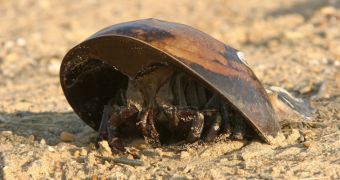The latest fossils found prove that the number of crawling creatures that crowded the Cambrian shores was larger than previously believed. And that they were not alone.
About 500 million years ago, during the Cambrian age, all of Earth's life was concentrated in the planetary oceans. Paleontologists assume that the first animals that sought to escape from the marine environment were doing so in order to avoid predators. Prior to reaching land and settling there, they used to live in tidal pools for long periods of time, possibly adapting to life on land during the process.
The fossil tracks discovered in Ontario, Canada, have led researchers to conclude that, at that time, the shores were patrolled by arthropods (small spider-like creatures). However, the way and the exact time when they got there still remain a mystery.
James “Whitey” Hagadorn from the Amherst College in Massachusetts claims, “They'd first have to cross an intertidal zone – a tidal flat. So we went exploring, looking for rocks of similar Cambrian age representing coastal sandy settings.” And they found them aplenty in Wisconsin, New York, showing signs of the crawl of arthropods through the mud. But it was another important finding that surprised the scientists even more.
Along with the tracks left by arthropods, some fossilized trails left by mollusks such as slugs or snails, as well as those of annelids (a type of worms), were present at the location of the tidal flats. “We knew arthropods should be there, but didn't know what else,” states Hagadorn.
“In a way the mollusks are more interesting because they weren't carrying a big shell around, and they had to deal with all of the problems of being on land.” Arthropods were covered, and still are today (hermit or horseshoe crabs, as well as insects), with a tough exoskeleton that protected them against the atmospheric conditions that could dry them up quickly, or against sun radiation.
Nevertheless, the mollusks lacked that protective cover. “[...] How did mollusks deal with this? They weren't carrying around a big shell,” Hagadorn asks. “Were they nocturnal? We see evidence of them burrowing beneath the surface, perhaps to avoid desiccation from the heat.”
This and the solution to many other problems are still eluding Hagadorn's grasp. “You're just a detective in deep time, putting pieces of the puzzle together,” he says. “Until someone comes and strikes it down. When it stands for a long time it becomes a theory, but I don't think we're anywhere near that yet.”

 14 DAY TRIAL //
14 DAY TRIAL //